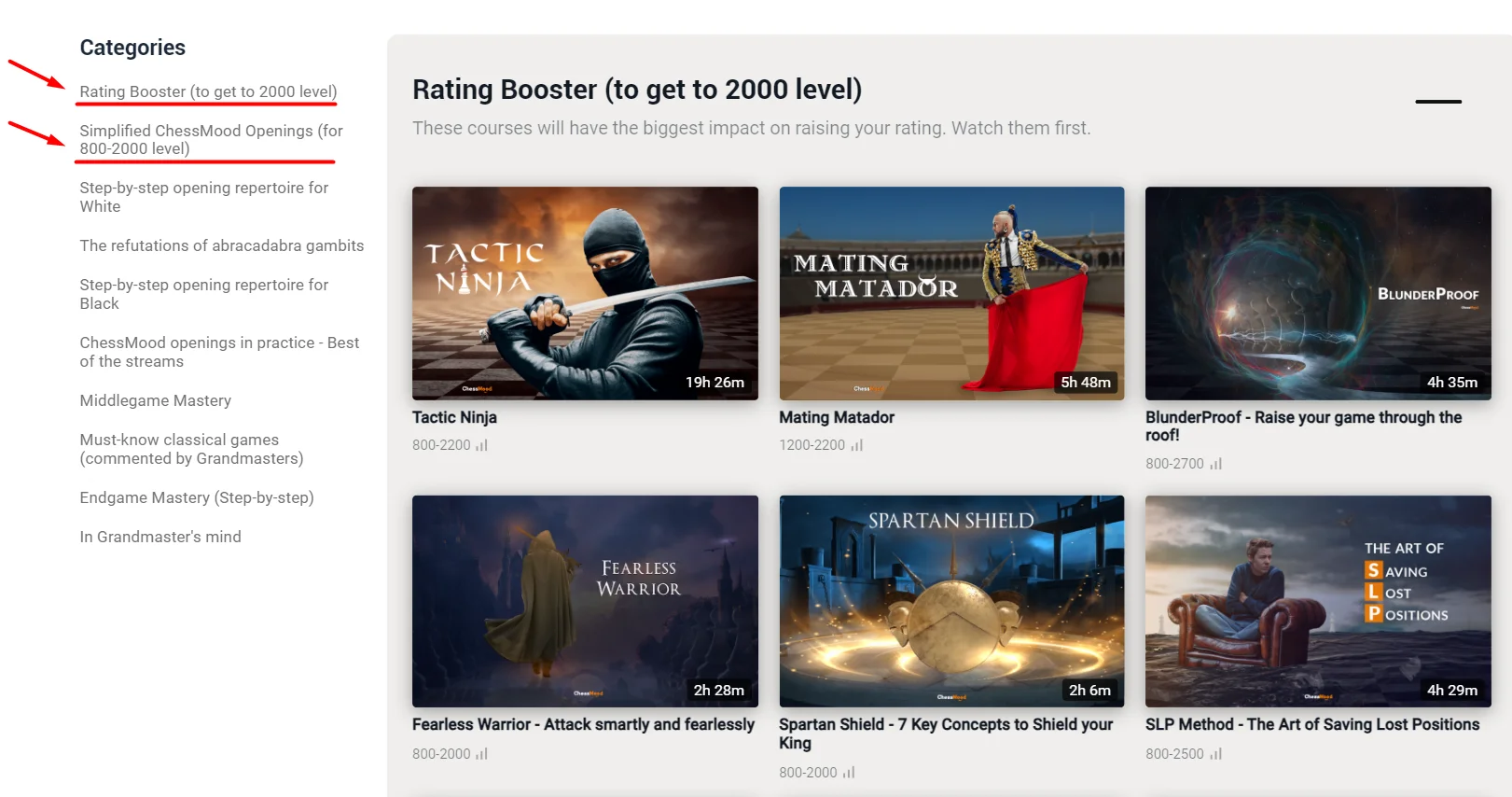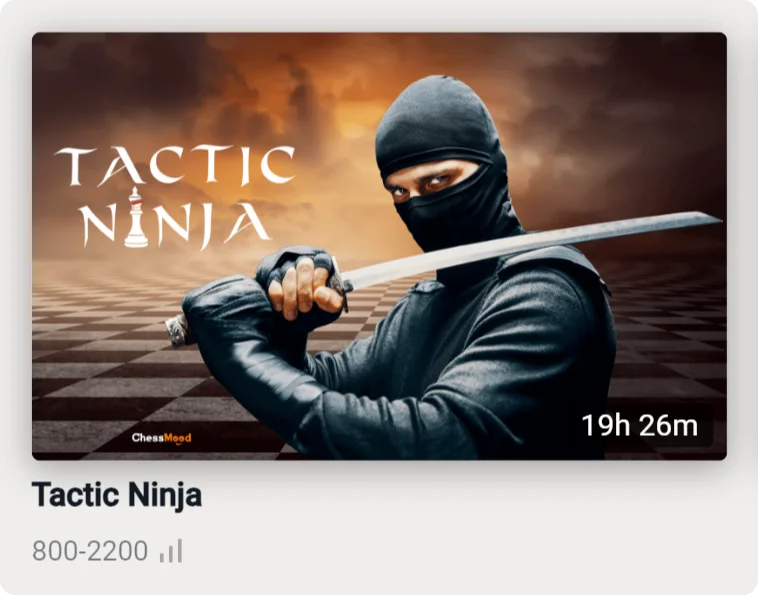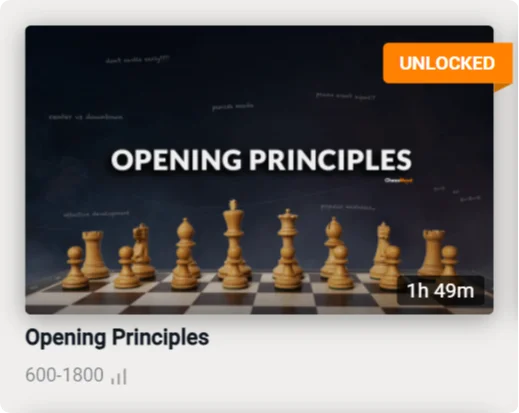Chess.com has over 100 million users! And only 6% have achieved a 1,500 rating!
Why?
The 1st answer that comes to our mind is - because it’s hard.
However, it’s not hard at all.
The main problem is that chess players try/experiment with all kinds of different improvement techniques. And when they google chess improvement, there is information chaos. And the worst part is that most of the content is created by beginners or marketers who don’t really play chess!
The good news: There is a proven, efficient way to hit the 1,500 level.
All you need to do is to follow the plan below.
When will you get a 1,500 rating?
This depends on how much time you can spend on chess and how accurately you’ll follow the improvement plan I’ll describe.
Unfortunately, you’ll not be the 1st one who achieved it by using this improvement plan, and you’ll not be the last.
But you’ll be in the 6% of the people who play chess and get there.
What if you never get there?
You can sue me 😁
Let’s go.
What do others do that is wrong?
The most common mistakes people make on this level are:
- Just playing and never studying
- Studying too much and not essential things. Playing too little, and never REALLY learning what they’ve studied.
- Not analyzing their games and not fixing their mistakes. And then they keep repeating the same errors over and over again.
What will you do differently?
These 5 steps:
- Maintain the right balance between studying, practicing, and fixing
- Study precisely what you need
- Know how to practice effectively
- Correct your main mistakes
- Have the right mindset
Now, let’s go through those 5 steps.
Step 1: The Right Balance
Please read the following article and come back.
It’s essential.
https://chessmood.com/blog/how-to-get-better-at-chess
Thanks!
Now you know the key to chess growth for every level!
The question is, what’s the right balance for your level?
For getting to the 1,500 level, you should keep around this ratio:
- Study - 35%
- Practice - 55%
- Fix - 10%
Yeah, most of the time, you should be playing!
When you cross 1500 and then get to 2,000, you’ll see that the better you become, the more you need to study, and this ratio drastically changes.
But for those below the 1,500 level, most of the time, you need to play!
With playing, you’ll get more connections between your brain neurons.
You’ll learn patterns and ideas on your own. Your brain will figure out lots of stuff.
(More about this topic you’ll learn in the 1st section of the BlunderProof course.)
And as you’ve learned in the above article, you’ll digest the information you learn.
You should study about 35% of the time. (It’s about ⅓ of the time you dedicate to chess)
And with the other 10%, you fix your mistakes, so you don’t repeat them.
Soon, you’ll see how to spend this time.
Step 2: Study
No more aimless wandering
Getting from 1,000 to 1,500 is harder than getting from 0 to 1,000.
And this is the level when many reach their 1st plateau.
Unfortunately, many get confused and start jumping from 1 source to another, trying to find that golden pill, which will get them to the 1,500 rating. They jump from right to left, from left to right. From one book to another, from a book to another course, and from a course to another course.
When this occurs, chess companies that are good with marketing, start bombarding them with promises and sell lots of stuff!
People buy too much unnecessary material and continue jumping from 1 source to another and get more confused.
If you were hooked like this, I’m sorry to hear that…
The good news is - no more!
Enough wandering.
Everything is laid out for you, step-by-step.
90% of all you need are in these 2 sections:

- Rating Booster
https://chessmood.com/courses#group=1
- Simplified ChessMood openings
https://chessmood.com/courses#group=2
The 4 essential areas to master
You’ll master these 4 essential areas for getting to the 1,500 level.
- Tactics
- Opening
- Middlegame
- Endgame
First, I’ll explain to you how to work on each of these areas and then what balance I recommend maintaining.
1. Tactics
How should you sharpen your tactical skills?
Very easy.
You don’t need different books, software, and all kinds of different stuff.
We have your back covered.
You just go through these 3 courses:
Course 1 - Tactic Ninja
https://chessmood.com/course/tactic-ninja
It’s not just a course. It’s Tactics training!
It goes topic-by-topic and comes with 1,000 puzzles.
Follow the instructions of the course and you’ll notice how your tactical skills improve day by day.
Course 2 - Mating Matador
The next step to further improving your tactics is to learn Mating Patterns.
We have a detailed course with 37 Mating Patterns.
https://chessmood.com/course/mating-matador
If you follow the course instructions, the day you complete both courses, your tactical skills will be even beyond the 1,500 level.
P. S. Here is an additional article on how to improve chess tactics:
https://chessmood.com/blog/improve-chess-tactics
Course 3 - BlunderProof
https://chessmood.com/course/blunderproof
As you’ll see, there are lots of psychological factors which will affect your tactical vision.
Also, reducing your blunders and noticing your opponents' blunders will be critical for raising your rating.
You’ll learn all the causes of blunders and how to avoid them. How you can stay focused and notice hidden tactics, and much more…
2. Opening
The 3 main mistakes people make
Most players make 3 main mistakes at this stage:
- They study openings without a fundamental understanding of the opening principles and the philosophy of the opening fight. As a result, they blindly memorize variations without understanding the fundamentals of the opening dynamics.
- They study openings too deeply, trying to win the game from the opening or trying to know everything.
- They study lots of trappy openings and variations. Yeah, they might win some rating points in the short term, but they lay a very bad foundation for their future growth.
Here is what I recommend you do:
1. Develop a strong foundation
At this level, many think they know the opening principles.
- Develop the pieces
- Fight for the center
- Castle early
But…!
The 3rd one - “castle early,” which you’ll find a lot on the internet, is a very wrong rule! Unfortunately, most of the articles and videos are made by beginners… And then some beginners learn from those sources and make content… As a result, there is lots of wrong advice on the internet. 🙁🙁
On top of that, there are more opening concepts than just those 3.
So, this is what I recommend you do.
Study the Opening Principle course first!
https://chessmood.com/course/opening-principles
- It’ll give you a huge advantage over other players below the 1,500 level.
- You’ll know what to fight for in the opening (50% don’t know, they just make random moves).
- You’ll know how to punish your opponents’ opening mistakes, those who don’t follow these principles.
- You’ll get good positions out of the opening and have an easy game later.
- In the future, no matter what openings you decide to learn, you’ll understand and learn them much more easily.
2. Create your opening repertoire
We cover your back again. You don’t need different books.
All you need is to go through these 2 courses.

WhiteMood and BlackMood openings.
https://chessmood.com/course/whitemood-openings
https://chessmood.com/course/blackmood-openings
You’ll create a step-by-step opening repertoire for both, White and Black.
Just don’t try to memorize everything in the courses. Understanding your plan after the 1st moves will be the most essential for your level.
Then download the PDF and PGN files from the courses, complete the homework, and then revise them from time to time.
A few adjustments for your level:
- If you hate playing with Black and are okay with White, you should learn BlackMood openings first. Otherwise, start from the White side.
- Most of your opponents on this level will answer your 1.e4 with 1…e5!
So, when you start watching the WhiteMood openings, spend more time on the 1st section. You’ll face this most of the time! - Watch until section 9 (you’ll learn how to play against the most common openings), then go to the BlackMood openings. And then come back to continue from section 10 of the WhiteMood.
3. Middlegame
On your level, 90% of the time, the middlegame part will be won by the player whose tactical skills are better!
So, if you are tactically sharp (recommendations are above), you will just kill the game.
And without working on middlegame specifically, you will most probably cross the 1,500.
But, to improve your middlegame further, I recommend you just go through the Rating Booster section, all the courses, one by one.
You’ll learn the key concepts of attacking and defending, how to save lost positions, win the winning ones, and much more…
4. Endgame
This is the most boring stage for most chess players.
And when they try to master this area, they often start with the wrong things and get confused in the chaos of information.
All you need is to:
- Understand the strategy in the endgame
- Learn the essential theoretical positions for your level
Strategy
When you understand the strategy in the endgames, and how you should think and find a plan, your endgames will immediately become interesting!
Our Endgame RoadMap course is one of the most popular and favorite courses among our students.
https://chessmood.com/course/chess-endgame-roadmap
Among all the 200+ hours of courses I’ve recorded, the Endgame Roadmap is the one I am most proud of.
You’ll love it, and the endgames will become very entertaining!
This is what you’ll learn!
.webp)
And you’ll never be confused about what to do in the endgame.
Theory
Most players either don’t learn any endgame theory or learn material that is too complicated…
You’ll need to learn just enough for your level, and only more when you advance.
All you need is to learn the basic Must-know endgame theory.
Here is everything you need to know below the 2,000 level.
https://chessmood.com/course/endgames-you-must-know
There are 18 sections.
You’ll not learn all endgame theory, but rather only what you Must-know.
When you advance and get 2,000+, then you can go to our Endgame Mastery section and learn more stuff.
+ Get into a Grandmaster’s mind
If you’re a PRO Member, you have access to our live training.
I highly recommend attending the training (or watching the recordings) when a Grandmaster plays and comments on games against players below the 2,000 level.
You’ll see how they think and punish the mistakes of this level.
This will be invaluable and one of the most efficient ways to spend your study time.
+ The bold-unbold technique
This is very important.
When we first learn new concepts, we have a tendency to forget some of them. But I found a nice way to reinforce new ideas.
It is called the “bold/unbold” technique.
It’s a proven technique many of our students successfully use. I do too.
Learn about it here:
https://chessmood.com/blog/bold-unbold-technique
+ What’s the study balance?
70% tactics
15% openings
15% Middlegame and Endgame
As we have already talked about, on this level mastering your tactical skills will have the biggest impact for hitting 1,500. That’s why you should spend 70% of your chess time on this area.
Having a good middlegame and understanding of what to do often will come from knowing your first moves of the openings and what your plan will be.
That’s why 15% of your time should be devoted to openings, and another 15% to the Middlegame and Endgame together.
If you’re struggling with openings, you can learn the openings first, and then go back to Tactics.
Or you can do them simultaneously. I don’t mean watching 2 courses at the same time on 1 monitor 😊 But rather 2 courses during the same period.
This is if you want to improve your tactics and opening simultaneously.
Some people love doing it this way, others — one topic at a time.
Find the one which is best for you
Step 3: Practice
As we reviewed already, you should spend most of your time (around 55%!) actually playing chess.
This includes:
- Offline tournaments
- Online games
- With training partners
Where should you play?
Both chess.com and lichess.org are okay.
I highly recommend sticking with Lichess.
It seems to me that chess.com constantly makes you feel you’re the worst player ever 😅
And offers “to improve your chess”… How? By buying all kinds of stuff you don’t need 😁
Lichess is my absolute favorite.
But the choice is yours.
What time control should you choose?
Overall, I don’t mind blitz games.
But on this level, I recommend playing more rapid games.
Bullet is forbidden 😊
If you very much love to play blitz and have fun, the fastest time control you should play with is 3+2. Always try to play with an increment. (Soon you’ll find out why).
The best time controls will be:
5+3,
10+5,
15+10,
30+20.
Those are time controls that many play on Lichess.
So you’ll easily find opponents.
More about what time control to choose and why you should always play with an increment can be found here:
https://chessmood.com/blog/what-chess-time-control-to-choose
My Golden Method
This is one of my most-read articles:
https://chessmood.com/blog/golden-method-to-increase-rating-in-chess
You’ll learn why I recommend sticking with 9-game sessions.
When you play with longer time controls, you can stick with 2-5 games per session.
The key is to always decide how many games you will play before starting the session.
A few more tips
Mindset is very important. I have many tips to share that will help you play better, maintain the right mood, and ultimately have more fun.
Whenever you find time, read the following articles:
How to raise your rating by cutting the losses
How to stop bad results
How to multiply good results
Legal doping and the Right Mood
How to handle bad mood
My top secret
Step 4 - Fixing
This is not the sexiest step and not the most fun part.
Unsurprisingly, most chess lovers skip this part.
But by doing it, you’ll get to the 1,500 level much faster than others.
And it doesn’t require a lot of time.
You should spend around 10% of your time fixing your mistakes.
Don’t try to understand every small mistake.
Instead, focus on big blunders. When you leave the pieces under attack, simple tactics that were overlooked, or missed mates in 2.
Check out this article to learn more:
https://chessmood.com/blog/analyze-blitz-chess-games
Step 5 - Mindset
I don’t want you to just improve your chess.
I want you to have fun at the same time.
Having the right mindset will not only bring more joy, when you do your favorite activity - chess, but it’ll also help you to grow much faster!
Try to spend some of your free time on our Blog:
https://chessmood.com/blog
And here are my top recommendations:
- Many focus on results and lose the fun part.
https://chessmood.com/blog/detachment - The secret to lasting love for chess and how to avoid emotional bankruptcy.
https://chessmood.com/blog/lasting-love-for-chess - Don’t just crave results. Deserve it. Often success will come later.
https://chessmood.com/blog/if-you-want-to-achieve-more-you-need-to-deserve-more - What stops you? Figure it out and address it:
https://chessmood.com/blog/what-is-the-but-that-is-holding-you-back
A few more recommendations
Find a training/sparring partner
There are lots of advantages in having a training partner.
Here are some of them:
- It’s more fun to not be alone on this journey
- You can psychologically support each other and challenge each other to grow
- You always have someone to play with
- You can study together
- You can analyze your games together
- And more…
You’ll find more about it in these articles:
The importance of having a training partner
How to find the perfect training partner
How to practice with your training partner
Do this every day
Whenever you have a day with very limited time, try to find 5-20 minutes to dedicate to puzzles (solving them or watching the Tactic Ninja course), or playing.
You want to build a connection between your neurons and not get rusty.
CoGro (Constant Growth)
I don’t know everything about chess improvement.
Anyone who claims they know everything, they’re either arrogant, idiots, or liars.
So far, I shared with you everything that works!
Many of our students who kept up with this study plan managed to cross the 1,500 level very fast.
Nothing is an experiment. All of this guidance works very effectively.
But I opened this “CoGro” part, to remind me about always becoming a better coach, coming back here and adding more stuff.
I will always keep my CoGro (Constant growth) as a coach.
I hope you’ll keep yours as a player.
Wishing you to have the Right Mood, have a fun journey, and hit your chess goals soon.
GM Avetik
P. S. Your feedback is highly appreciated.
You can share it here:
https://forms.gle/2z5FEzX2zwzEkpLt9








